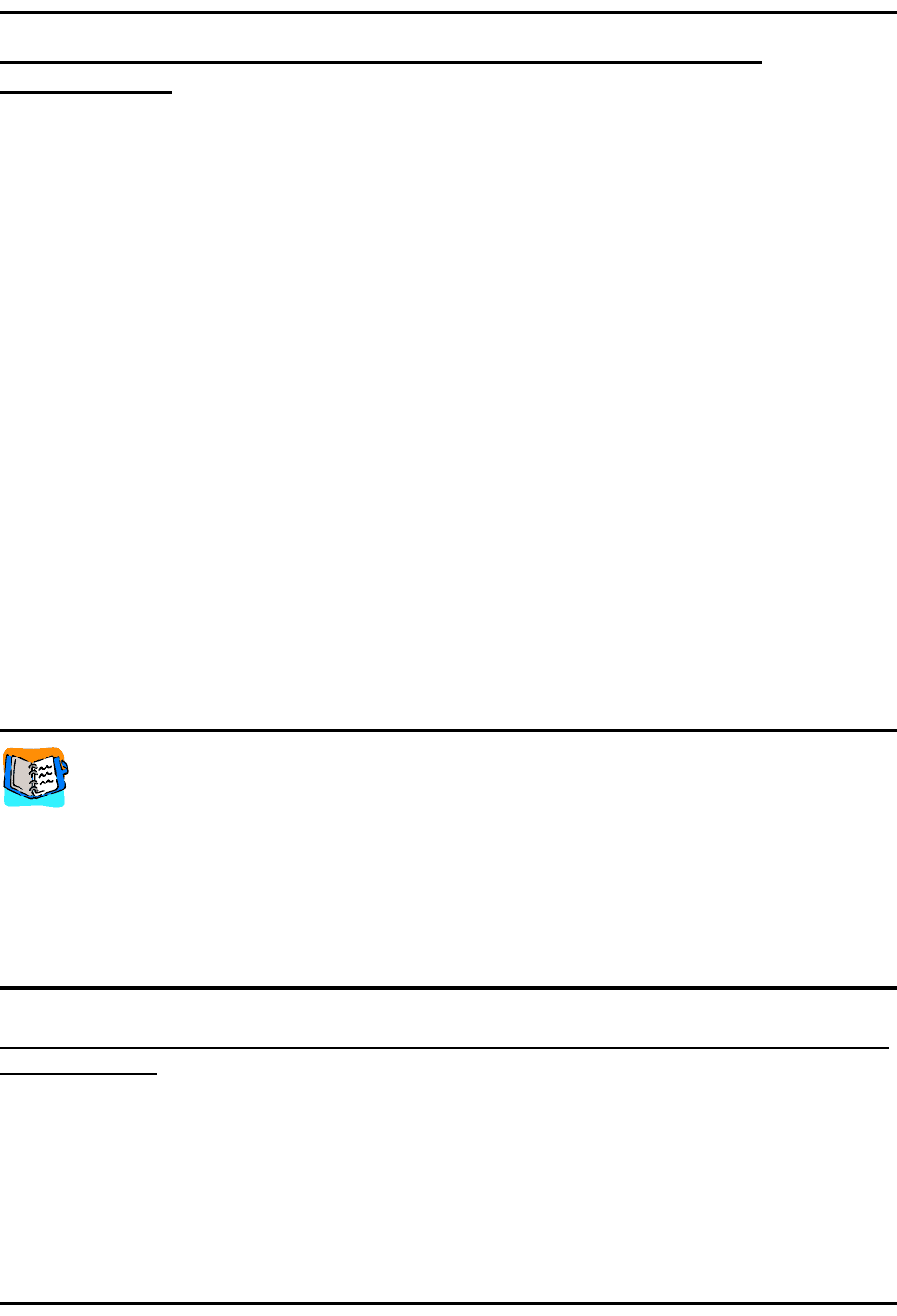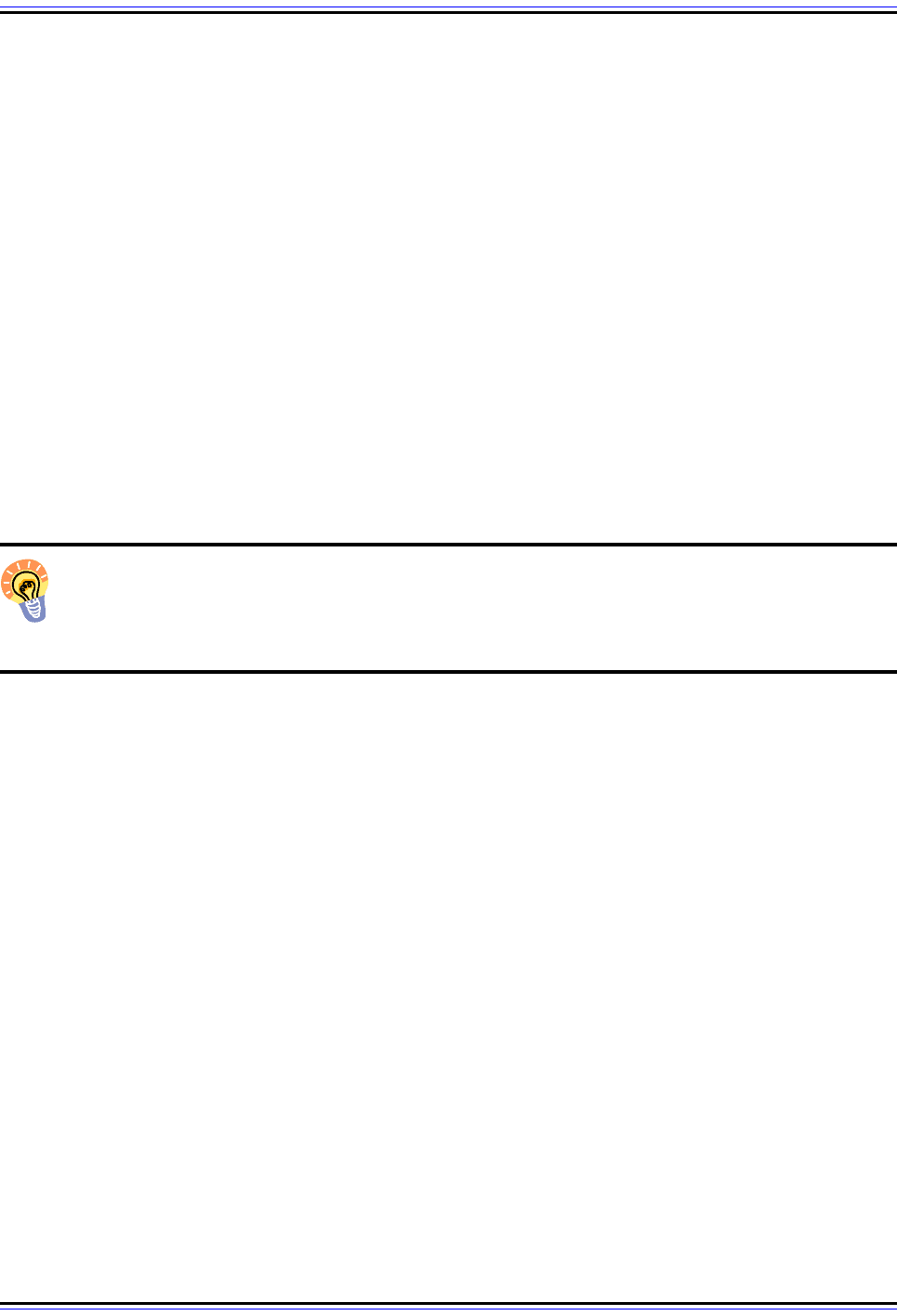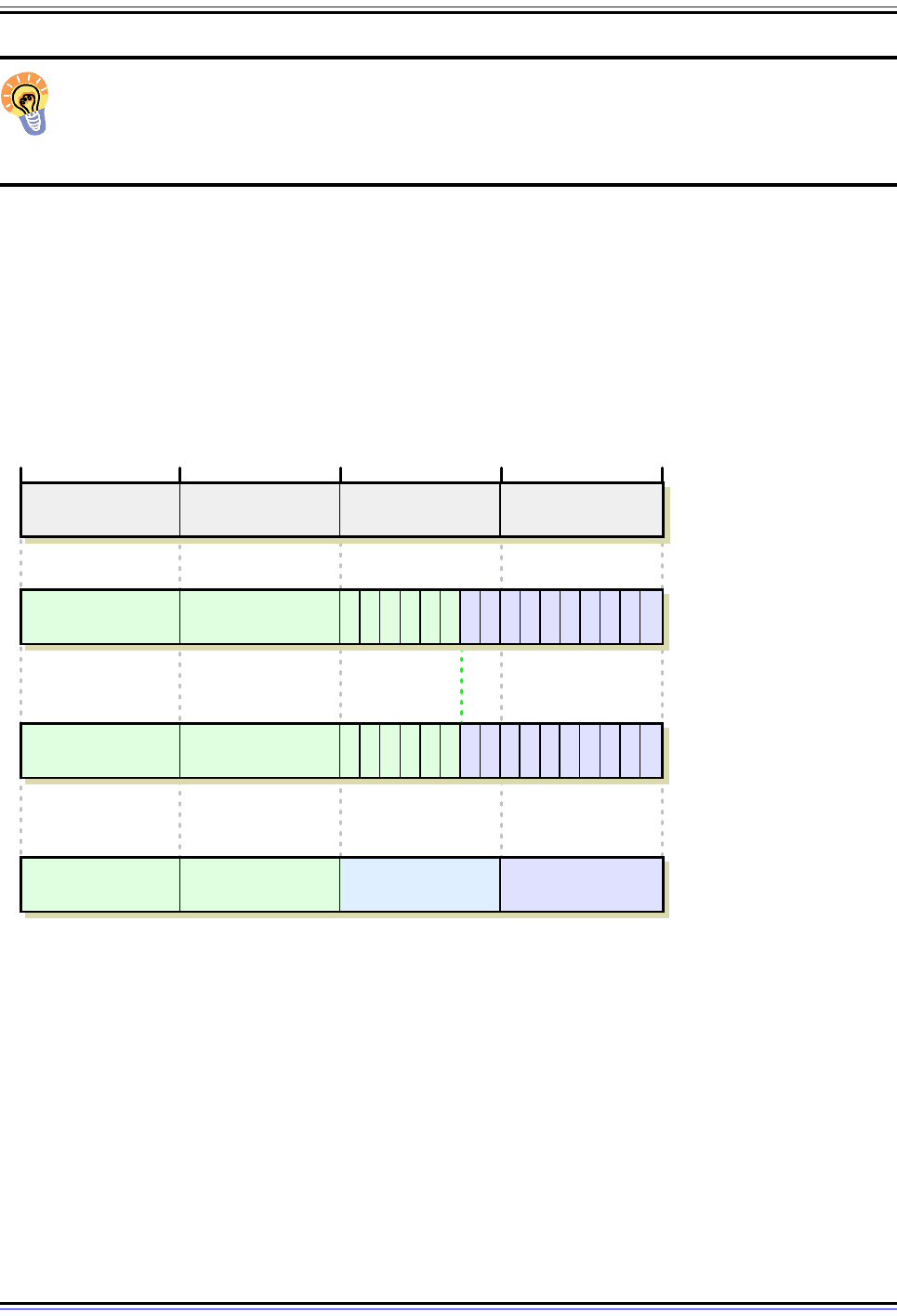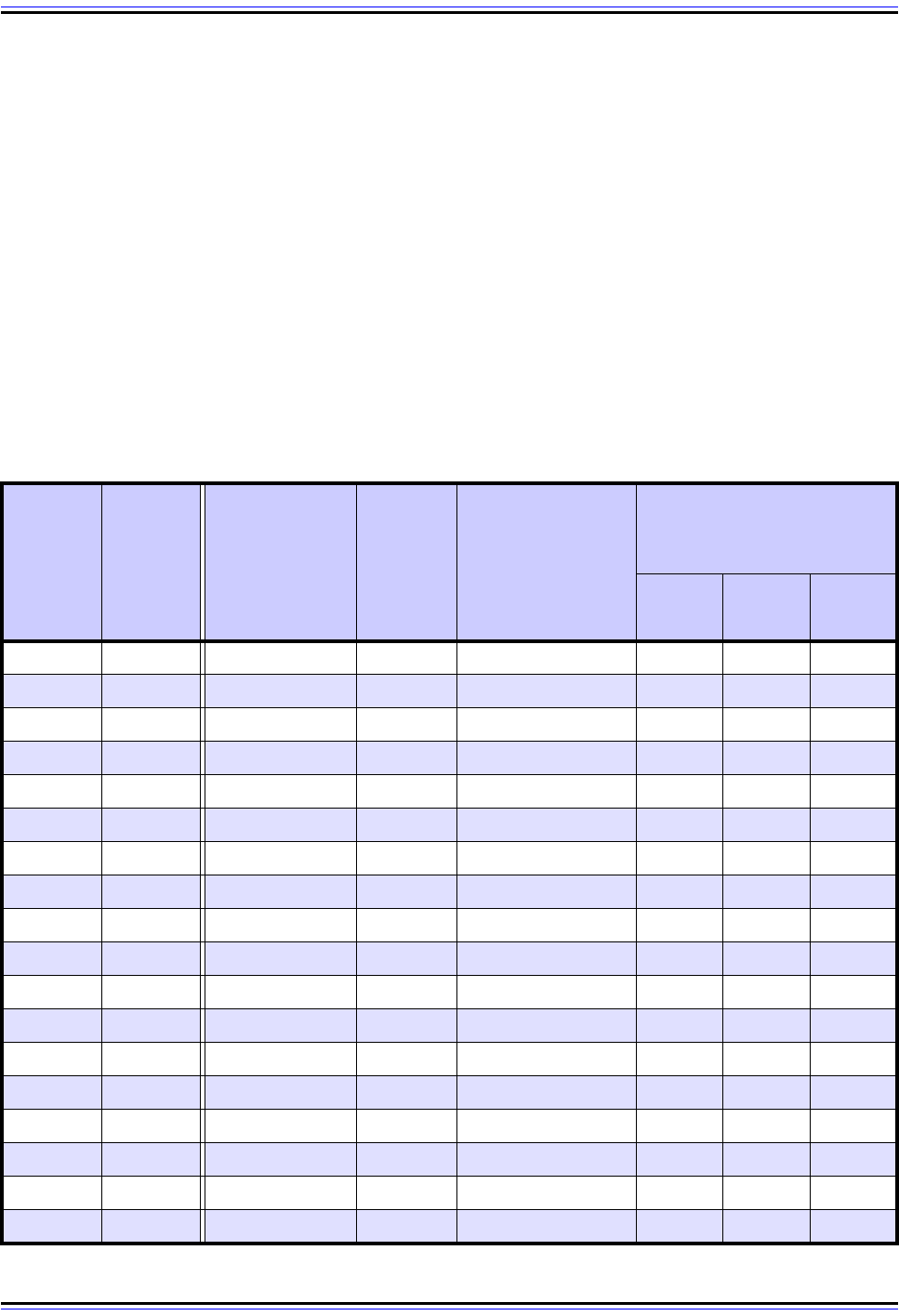Charles M. Kozierok The TCP-IP Guide
Подождите немного. Документ загружается.


The TCP/IP Guide - Version 3.0 (Contents) ` 401 _ © 2001-2005 Charles M. Kozierok. All Rights Reserved.
In closing, remember the following quick summary when working with IP addresses in a
subnet environment:
1. The network ID is the same for all hosts in all subnets, and all subnets in the network.
2. The subnet ID is the same for all hosts in each subnet, but unique to each subnet in
the network.
3. The host ID is unique within each subnet. Each subnet has the same set of host IDs.
4. Subnetting is fun!

The TCP/IP Guide - Version 3.0 (Contents) ` 402 _ © 2001-2005 Charles M. Kozierok. All Rights Reserved.
IP Classless Addressing: Classless Inter-Domain Routing (CIDR) /
"Supernetting"
As the early Internet began to grow dramatically, three main problems arose with the
original “classful” addressing scheme. These difficulties were addressed partially through
subnet addressing, which provides more flexibility for the administrators of individual
networks on an internet. Subnetting, however, doesn't really tackle the problems in general
terms. Some of these issues remain due to the use of classes even with subnets.
While development began on IP version 6 and its roomy 128-bit addressing system in the
mid-1990s, it was recognized that it would take many years before widespread deployment
of IPv6 would be possible. In order to extend the life of IP version 4 until the newer IP
version 6 could be completed, it was necessary to take a new approach to addressing IPv4
devices. This new system calls for eliminating the notion of address classes entirely,
creating a new classless addressing scheme sometimes called Classless Inter-Domain
Routing (CIDR).
In this section I describe modern classless IP addressing. I begin with an overview of the
concepts behind classless addressing and the idea behind “supernetting”, including why it
was created and what its advantages and disadvantages are. I then define CIDR and
describe how the system works in more detail, including the notation used for address
blocks. I list each of the CIDR address block sizes and show how they relate to the older
class A, B and C networks. I conclude with an example of CIDR addressing, which is similar
to the practical subnetting section prior to this one, but focused on CIDR and a bit more
condensed.
Background Information: Classless IP addressing represents the latest evolution
of IP addressing, following on the heels of subnetting and the original “classful”
addressing system described in preceding sections. Understanding classless IP
addressing and routing requires at least some familiarity with these older IP addressing
methods. If you have come to this section without reading the preceding sections on
“classful” addressing and subnetting, I strongly advise reviewing them first. If you under-
stand subnetting but aren't familiar with how Variable Length Subnet Masking (VLSM)
works, reading the topic on VLSM is a good idea, since CIDR is similar to VLSM in many
ways.
IP Classless Addressing and "Supernetting" Overview, Motivation, Advantages and
Disadvantages
Subnet addressing was an important development in the evolution of IP addressing,
because it solved some important issues with the conventional, two-level class-based
addressing scheme. Subnetting's contribution to ease in IP addressing was allowing each
network to have its own two-level hierarchy, giving the administrator of each network the
equivalent of an “internet within the Internet”.

The TCP/IP Guide - Version 3.0 (Contents) ` 403 _ © 2001-2005 Charles M. Kozierok. All Rights Reserved.
When we looked at the advantages of subnetting, we saw that one was that subnetting was
local within each organization, and “invisible” to other organizations. This is an advantage in
that it lets each organization tailor its network without other groups having to worry about
the details of how this is done. Unfortunately, this “invisibility” also represents a key disad-
vantage of subnetted “classful” addressing: it cannot correct the fundamental inefficiencies
associated with that type of addressing, because organizations are still assigned address
blocks based on classes.
The Main Problem With "Classful" Addressing
A key weakness of regular subnetting is low “granularity”. A Class B address block contains
a very large number of addresses (65,534) but a Class C block has only a relatively small
number (254). There are many thousands of “medium-sized” organizations who need more
than 254 IP addresses, but a small percentage of these need 65,534 or anything even close
to it. (The lack of a good match to a medium-sized organization with 5,000 hosts is illus-
trated in Figure 64.) When setting up their networks, these companies and groups would
tend to request Class B address blocks and not Class C blocks because they need more
than 254, without considering how many of the 65,000-odd addresses they really would
use.
Now, due to how the classes of the older system were designed, there are over 2 million
Class C address blocks, but only 16,384 Class Bs. While 16,384 seems like a lot at first
glance, there are millions of organizations and corporations around the world. Class B
allocations were being consumed at a rapid pace, while the smaller Class C networks were
relatively unused.
The folks handing out Internet addresses needed a way to better utilize the address space
so it would not run out before the transition to IP version 6. Subnetting didn't help a great
deal with this problem. Why? Because it only works within the “classful” address blocks. If
an organization needing 2,000 IP addresses requests a Class B block, they could use
subnetting to more efficiently manage their block. However, subnetting could do nothing
about the fact that this organization would never use over 62,000 of the addresses in its
block—about 97% of their allocated address space.
The only solution to this would be to convince—or at worst case, force—companies to use
many smaller Class C blocks instead of “wasting” the bulk of a Class B assignment. Many
organizations resisted this due to the complexity involved, and this caused the other main
problem that subnetting didn't correct: the growth of Internet routing tables. Replacing one
Class B network with 10 Class Cs means ten times as many entries for routers to keep
track of.
A Better Solution: Eliminate Address Classes
It was clear that as long as there were only three sizes of networks, the allocation efficiency
problem could never be properly rectified. The solution was to get rid of the classes
completely, in favor of a classless allocation scheme. This system would solve both of the
main problems with “classful” addressing: inefficient address space use, and the
exponential growth of routing tables.

The TCP/IP Guide - Version 3.0 (Contents) ` 404 _ © 2001-2005 Charles M. Kozierok. All Rights Reserved.
This system was developed in the early 1990s and formalized in 1993 in RFCs 1517, 1518,
1519 and 1520. The technology was called Classless Inter-Domain Routing (CIDR).
Despite this name, the scheme deals with both addressing and routing matters, since they
are inextricably linked.
The idea behind CIDR is to adapt the concept of subnetting a single network to the entire
internet. In essence, then, classless addressing means that instead of breaking a particular
network into subnets, we can aggregate networks into larger “supernets”. CIDR is
sometimes called supernetting for this reason: it applies the principles of subnetting to
larger networks. It is this aggregation of networks into supernets that allowed CIDR to
resolve the problem of growing Internet routing tables.
Of course, if we are going to apply subnetting concepts to the entire internet, we need to be
able to have subnets of different sizes. After all, that's one of our primary goals in elimi-
nating the classes. So, more accurately, CIDR is an internet-wide application of not regular
one-level subnetting, but of Variable Length Subnet Masking (VLSM). Just as VLSM lets us
split a network as many times as we want to create subnets, “sub-subnets” and “sub-sub-
subnets”, CIDR lets us do this with the entire Internet, as many times as needed.
Key Concept: Classless Inter-Domain Routing (CIDR) is a system of IP addressing
and routing that solves the many problems of “classful” addressing by eliminating
fixed address classes in favor of a flexible, multiple-level, hierarchical structure of
networks of varying size.
The Many Benefits of Classless Addressing and Routing
CIDR provides numerous advantages over the “classful” addressing scheme, whether or
not subnetting is used:
☯ Efficient Address Space Allocation: Instead of allocating addresses in fixed-size
blocks of low granularity, under CIDR addresses are allocated in sizes of any binary
multiple. So, a company that needs 5,000 addresses can be assigned a block of 8,190
instead of 65,534, as shown in Figure 81. Or, to think of it another way, the equivalent
of a single Class B network can be shared amongst 8 companies that each need 8,190
or fewer IP addresses.
☯ Elimination of Class Imbalances: There are no more class A, B and C networks, so
there is no problem with some portions of the address space being widely used while
others are neglected.
☯ Efficient Routing Entries: CIDR's multiple-level hierarchical structure allows a small
number of routing entries to represent a large number of networks. Network descrip-
tions can be “aggregated” and represented by a single entry. Since CIDR is
hierarchical, the detail of lower-level, smaller networks can be hidden from routers that
move traffic between large groups of networks. This is discussed more completely in
the section on IP routing issues.

The TCP/IP Guide - Version 3.0 (Contents) ` 405 _ © 2001-2005 Charles M. Kozierok. All Rights Reserved.
☯ No Separate Subnetting Method: CIDR implements the concepts of subnetting
within the internet itself. An organization can use the same method used on the
Internet to subdivide its internal network into subnets of arbitrary complexity without
needing a separate subnetting mechanism.
The Main Disadvantage of CIDR: Complexity
Since the main benefit of “classful” addressing was its simplicity, it's no surprise that the
main drawback of CIDR is its greater complexity. One issue is that it is no longer possible to
determine by looking at the first octet to determine how many bits of an IP address
represent the network ID and how many the host ID. A bit more care needs to be used in
setting up routers as well, to make sure that routing is accomplished correctly.
Figure 81: Classless Addressing (CIDR) Solves The “Granularity Problem”
Figure 64 illustrated the primary problem with “classful” addressing: the great distance between the size of
Class B and Class C networks. CIDR solves this issue by allowing any number of bits to be used for the
network ID. In the case of an organization with 5,000 hosts, a /19 network with 8,190 hosts can be assigned.
This reduces the address space waste for such an organization by about 95%.
Hosts in Class C
Network (254)
Hosts Needed
By Organization
(5,000)
Hosts in Class B
Network (65,534)
Hosts In CIDR
/19 Network
(8,190)

The TCP/IP Guide - Version 3.0 (Contents) ` 406 _ © 2001-2005 Charles M. Kozierok. All Rights Reserved.
IP "Supernetting": Classless Inter-Domain Routing (CIDR) Hierarchical Addressing
and Notation
When we first looked at IP addressing, we saw that IP addresses are designed to be
divided into a network identifier and host identifier. Then, when subnets were introduced,
we “stole” bits from the host ID to create a subnet ID, giving the IP address a total of three
hierarchical levels. With VLSM, we further subnetted the subnets, taking more bits from the
host ID to give us a multiple-level hierarchy with “sub-subnets”, “sub-sub-subnets” and so
forth.
In a classless environment, we completely change how we look at IP addresses, by
applying VLSM concepts not just to one network, but to the entire Internet. In essence, the
Internet becomes just one giant network that is “subnetted” into a number of large blocks.
Some of these large blocks are then broken down into smaller blocks, which can in turn be
broken down further. This breaking down can occur multiple times, allowing us to split the
“pie” of Internet addresses into slices of many different sizes, to suit the needs of
organizations.
As the name implies, classless addressing completely eliminates the prior notions of
classes. There are no more Class A, B, C blocks that are divided by the first few bits of the
address. Instead, under CIDR, all Internet blocks can be of arbitrary size. Instead of having
all networks use 8 (Class A), 16 (Class B) or 24 (Class C) bits for the network ID, we can
have large networks with, say, 13 bits for the network ID (leaving 19 bits for the host ID), or
very small ones that use 28 bits for the network ID (only 4 bits for the host ID). The size of
the network is still based on the binary power of the number of host ID bits, of course.
Recall that when we used subnetting, we had a problem: subnetting could be done by
taking any number of available host ID bits, so how would devices know where the line was
between the subnet ID and host ID? The same problem occurs under CIDR. There are no
classes, so we can't tell anything by looking at the first few bits of an IP address. Since
addresses can have the dividing point between host ID and network ID occur anywhere, we
need additional information in order to interpret IP addresses properly. Under CIDR, of
course, this impacts not only addresses within an organization but in the entire Internet,
since there are no classes and each network can be a different size.
CIDR ("Slash") Notation
Just as subnetting required the use of a subnet mask to show which bits belong to the
network ID or subnet ID and which to the host ID, CIDR uses a subnet mask to show where
the line is drawn between host ID and network ID. However, for simplicity, under CIDR we
don't usually work with 32-bit binary subnet masks. Instead, we use slash notation, more
properly called CIDR notation. In this method, we show the size of the network, sometimes
called the prefix length, by following an IP address by an integer that tells us how many bits
are used for the network ID (prefix).

The TCP/IP Guide - Version 3.0 (Contents) ` 407 _ © 2001-2005 Charles M. Kozierok. All Rights Reserved.
Key Concept: Since there are no address classes in CIDR, one cannot tell the size
of the network ID of an address from the address alone. In CIDR, the length of the
prefix (network ID) is indicated by placing it following a slash after the address. This
is called CIDR notation or slash notation.
For example, consider the network specification 184.13.152.0/22. The “22” means this
network has 22 bits for the network ID and 10 bits for the host ID. This is equivalent to
specifying a network with an address of 184.13.152.0 and a subnet mask of 255.255.252.0,
as you can see in Figure 82. This sample network provides a total of 1,022 hosts (2
10
minus
2). The table in the following topic shows all the different possible network sizes that can be
configured under CIDR.
Figure 82: CIDR (“Slash”) Notation and Its Subnet Mask Equivalent
A classless network is normally specified in CIDR or “slash” notation, such as this example: 184.13.152.0/22.
Here, the “/22” means the first 22 bits of the address are the network ID. The equivalent subnet mask can be
calculated by creating a 32-bit number with 22 ones followed by 10 zeroes.
81624320
Classless Network
184.13.152.0/22
184 13 152 0
255 255 252 0
Binary Subnet
Mask for /22
Network
Binary Subnet
Mask Converted
to Dotted Decimal
(255.255.252.0)
10111000 00001101 1 0 0 1 1 0 0 0 0 0 0 0 0 0 0 0
22 Bits for Prefix
(Network ID) and
10 Bits for Host ID
11111111 11111111 1 1 1 1 1 1 0 0 0 0 0 0 0 0 0 0

The TCP/IP Guide - Version 3.0 (Contents) ` 408 _ © 2001-2005 Charles M. Kozierok. All Rights Reserved.
Note: You may recall my mentioning that under “classful” subnetting, the bits used
for the subnet ID did not need to be contiguous. Even though to avoid confusion
this was rarely if ever used, non-contiguous subnet ID bits were possible. Under
CIDR, the requirement for contiguous subnet ID bits has been made official—you could not
use slash notation otherwise.
"Supernetting": Subnetting the Internet
In theory, then, what CIDR does is provide the central address-assignment authority with
the flexibility to hand out address blocks of different sizes to organizations based on their
need. However, when CIDR was developed, a shift was made in the method by which
public IP addresses were assigned. Having everyone in the world attempt to get addresses
from one organization wasn't the best method. It was necessary under the “classful”
scheme because the hierarchy was only two levels deep: IANA handed out network IDs to
everyone, who then assigned host IDs (or subnetted).
Under CIDR we have many hierarchical levels: we split big blocks into smaller blocks and
then still-smaller blocks, and so on. It makes sense to manage blocks in a similar hierar-
chical manner as well. So, what happens is that IANA/ICANN divides addresses into large
blocks, which it distributes to the four regional Internet registries (RIRs): APNIC, ARIN,
LACNIC and RIPE NCC. These then further divide the address blocks and distribute them
to lower-level national Internet registries (NIRs), local Internet registries (LIRs) and/or
individual organizations such as Internet Service Providers (ISPs). This is all explained in
the background topic on Internet authorities and registries.
ISPs can then divide these blocks into smaller ones that they allocate to their customers.
These customers are sometimes smaller ISPs themselves, which repeat the process. They
split their blocks into pieces of different sizes and allocate them to their customers, some of
whom are even smaller ISPs and some of whom are “end users”. The number of times this
can occur is limited only by how many addresses are in the original block.
It's also worth noting that while CIDR is based on subnetting concepts, subnetting itself is
not used in CIDR—or at least, not in the way it is used under “classful” addressing. There is
no explicit subnetting using a subnet ID within CIDR: all IP addresses are interpreted only
as having a network ID and a host ID. An organization does the equivalent of subnetting by
dividing its own network into subnetworks using the same general method that ISPs do.
This probably seems a bit confusing. Later in this section I have provided a detailed
example of how hierarchical address block assignment and splitting works under CIDR.
Common Features of "Classful" and Classless Addressing
Note that there are a few aspects of addressing that were defined under the “classful”
scheme that don't change under CIDR:

The TCP/IP Guide - Version 3.0 (Contents) ` 409 _ © 2001-2005 Charles M. Kozierok. All Rights Reserved.
☯ Private Address Blocks: Certain blocks of addresses are still reserved for private
network addressing. These addresses are not directly routed on the Internet, but can
be used in conjunction with Network Address Translation (NAT) to allow IP hosts
without public addresses to access the Internet.
☯ Addresses With Special Meanings: The special meanings assigned to certain
network ID and host ID patterns are the same as before. This is also why we still must
subtract two from the number of hosts in each network: for the all-zeroes case that
refers to the network as a whole, and the all-ones address used for broadcast.
☯ Loopback Addresses: The network 127.0.0.0 is still reserved for loopback function-
ality. (In CIDR it is given the notation 127.0.0.0/8).
Finally, note that use of classless addressing requires hardware and software designed to
handle it. If the hardware and software are still assuming that they are operating in a
“classful” environment, they will not properly interpret addresses. Since CIDR has now
been around for over a decade, this is usually not a problem with modern systems.
IP Classless Addressing Block Sizes and "Classful" Network Equivalents
Since CIDR allows us to divide IP addresses into network ID and host ID along any bit
boundary, it permits the creation of dozens different sizes of networks. As with subnetting,
the size of network is a trade-off between the number of bits used for the network ID and the
number used for the host ID. Unlike conventional subnetting, where a single choice is made
for all subnets, CIDR allows many levels of hierarchical division of the Internet, so many
sizes of networks exist simultaneously. Larger networks are created and subdivided into
smaller ones, as we saw in the previous topic.
Since many people are used to looking at IP address blocks in terms of their “classful”
sizes, it is common to express CIDR address blocks in terms of their “classful” equivalents.
First of all, it should be simple at this point to see that a CIDR “/8” network is equal in size to
a Class A network; a “/16” is equivalent to a Class B; a “/24” is equivalent to a Class C. This
is of course because Class A networks use 8 bits for the network ID, Class Bs use 16, and
Class Cs use 24. However, remember that these CIDR equivalents do not need to have any
particular ranges for their first octets as in the “classful” scheme.
Each time we reduce the prefix length, we are defining a network about double the size of
the one with the higher number, since we have increased the number of bits in the host ID
by one. So, a “/15” network is equal in size to two “/16”s.
Table 56 shows each of the possible theoretical ways to divide the 32 bits of an IP address
into network ID and host ID bits under CIDR. For each, I have shown the number of hosts in
each network, and the way a network of each size is represented in both slash notation and
as a conventional subnet mask. I have also shown the equivalent number of Class A, Class
B and Class C networks for each.
A few things to remember in looking at this table:

The TCP/IP Guide - Version 3.0 (Contents) ` 410 _ © 2001-2005 Charles M. Kozierok. All Rights Reserved.
☯ Some of the entries shown are more theoretical than practical, and are included
merely for completeness. This is particularly the case with the larger networks. For
example, I doubt anyone ever actually works with a /1 or /2 size CIDR network; there
would only be two of the former and four of the latter encompassing the entire IP
address space! Most of the time you will be working with smaller networks, /16 and
below.
☯ Under normal circumstances, you cannot have a /31 or /32 CIDR network since they
would have zero valid host IDs. (There is a special case: /31 networks can be used for
point-to-point links, where it is obvious who the intended recipient is of each trans-
mission, and where broadcasts are not necessary. This is described in RFC 3021.)
☯ In the columns showing the number of equivalent Class A, B and C networks I have
only shown numbers in the range of 1/256th to 256 for simplicity. Obviously, a /6
network, in addition to being equal in size to 4 Class A networks, also equals 1,024
Class Bs and 262,144 Class C networks, but few people would bother referring to a /6
as being 262,144 Class Cs.
Table 56: CIDR Address Blocks and “Classful” Address Equivalents (Page 1 of 2)
# of Bits
For
Network
ID
# of Bits
For Host
ID
# of Hosts Per
Network
Prefix
Length
in Slash
Notation
Equivalent
Subnet Mask
# of Equivalent
“Classful” Addressing
Networks
Class
A
Class
B
Class
C
1 31 2,147,483,646 /1 128.0.0.0 128 — —
2 30 1,073,741,822 /2 192.0.0.0 64 — —
3 29 536,870,910 /3 224.0.0.0 32 — —
4 28 268,435,454 /4 240.0.0.0 16 — —
5 27 134,217,726 /5 248.0.0.0 8 — —
6 26 67,108,862 /6 252.0.0.0 4 — —
7 25 33,554,430 /7 254.0.0.0 2 — —
8 24 16,777,214 /8 255.0.0.0 1 256 —
9 23 8,388,606 /9 255.128.0.0 1/2 128 —
10 22 4,194,302 /10 255.192.0.0 1/4 64 —
11 21 2,097,150 /11 255.224.0.0 1/8 32 —
12 20 1,048,574 /12 255.240.0.0 1/16 16 —
13 19 524,286 /13 255.248.0.0 1/32 8 —
14 18 262,142 /14 255.252.0.0 1/64 4 —
15 17 131,070 /15 255.254.0.0 1/128 2 —
16 16 65,534 /16 255.255.0.0 1/256 1 256
17 15 32,766 /17 255.255.128.0 — 1/2 128
18 14 16,382 /18 255.255.192.0 — 1/4 64
